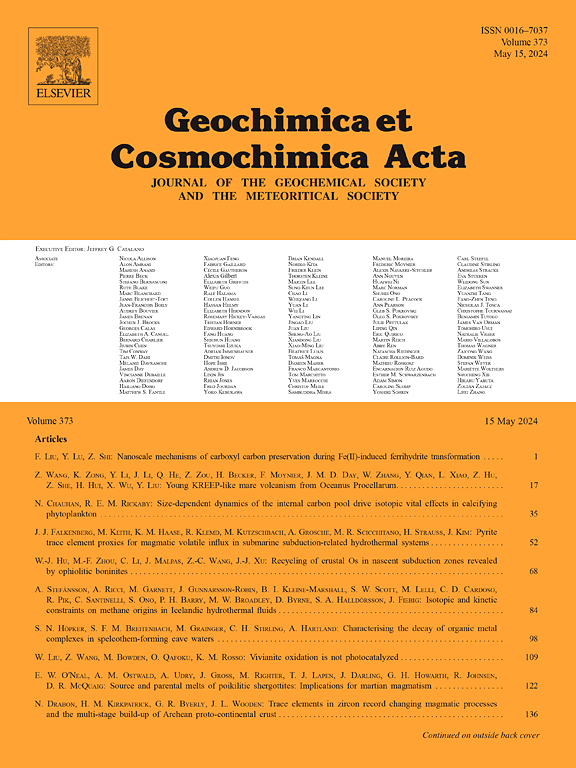NdPO4 solubility and aqueous Neodymium speciation in supercritical fluids: An experimental study at 500–700 °C and 1.7 kbar
IF 5
1区 地球科学
Q1 GEOCHEMISTRY & GEOPHYSICS
引用次数: 0
Abstract
A key aspect in the formation of rare earth elements (REE) deposits is the role of REE transport as aqueous REE complexes in supercritical hydrothermal solutions, where the nature of the aqueous complex is controlled by solution composition, temperature and pressure. Despite chloride being considered as one of the most abundant transporting ligands in magmatic-hydrothermal fluids, experimental investigations on the stability of aqueous REE chloride complexes are scarce above 300 °C. In this study, synthetic NdPO4 crystals were reacted with non-saline and saline (0, 0.05 and 0.5 mNaCl), acidic (0.01 mHCl) aqueous solutions in a series of solubility experiments conducted at 500 − 700 °C and 1.7 kbar, where the solubilities were determined using a stable Nd isotope (145Nd isotope spike) dilution technique. NdPO4 solubility ranges between 28 ppm and 10,858 ppm, where solubility increases with both temperature and salinity. At 500 °C, log mNdPO4 increases from −3.93 to −1.60 and there is a strong correlation between NdPO4 solubility and NaCl concentrations (slope of 1.2 ± 0.3), indicating stabilization of the Nd chloride aqueous complexes with a stoichiometry corresponding to NdCl2+. At 600 °C, this correlation is weaker (slope of 0.4, log mNdPO4 increases from −2.63 to −1.88) indicating the stabilization of both Nd chloride and hydroxyl species controlling solubility. At 700 °C, NdPO4 solubility is largely independent of NaCl concentration indicating that solubility is controlled by Nd hydroxyl complexes, where stoichiometry suggests the neutral Nd(OH)30 species is dominant. The solubility product (Ksp) of NdPO4 is derived from experimental data with the relation: log Ksp = -41.81 – 0.057T – 20987/T, with T temperature in Kelvin. Comparison of the measured Nd phosphate solubility to thermodynamic predictions using the available Helgeson-Kirkham-Flowers equation of state parameters for aqueous Nd complexes indicate that predictions are up to three orders of magnitude lower compared to experimental observations. This discrepancy is most pronounced in saline solutions, suggesting that thermodynamic properties of the REE chloride species in supercritical fluids require revision. Numerical simulations of fluid-rock interaction between acidic, saline fluids and a Strange Lake felsic mineral assemblage demonstrates that NdPO4 solubility predictions from models are four to six orders of magnitude lower than those calculated based on empirical fits from experiments, which suggests that acidic, saline fluids may play an important role in mobilizing large amounts of light REE from 450 to 700 °C.
超临界流体中NdPO4溶解度和水中钕形态:500-700°C和1.7 kbar的实验研究
稀土元素(REE)矿床形成的一个关键方面是稀土元素在超临界水热溶液中作为水相稀土配合物的输运作用,其中水相配合物的性质受溶液组成、温度和压力的控制。尽管氯化物被认为是岩浆热液中最丰富的运输配体之一,但对300℃以上水相REE氯化物配合物稳定性的实验研究很少。在这项研究中,合成的NdPO4晶体与非盐水、盐水(0、0.05和0.5 mNaCl)、酸性(0.01 mHCl)水溶液在500 - 700°C和1.7 kbar下进行了一系列溶解度实验,其中使用稳定的Nd同位素(145Nd同位素峰)稀释技术测定了溶解度。NdPO4的溶解度范围在28 ppm到10858 ppm之间,其溶解度随温度和盐度的增加而增加。在500°C时,NdPO4的对数从- 3.93增加到- 1.60,NdPO4的溶解度与NaCl浓度之间存在很强的相关性(斜率为1.2±0.3),表明氯化Nd的水络合物具有与NdCl2+相对应的化学计量学稳定性。在600°C时,这种相关性较弱(斜率为0.4,对数mnndpo4从−2.63增加到−1.88),表明氯化Nd和羟基的稳定控制了溶解度。在700°C时,NdPO4的溶解度在很大程度上与NaCl浓度无关,表明其溶解度受Nd羟基配合物控制,其中化学计量学表明中性Nd(OH)30占主导地位。根据实验数据得到NdPO4的溶解度积Ksp,其关系式为log Ksp = -41.81 - 0.057T - 20987/T, T温度单位为开尔文。利用现有的Helgeson-Kirkham-Flowers状态参数方程,将测量到的磷酸钕溶解度与热力学预测进行了比较,结果表明,与实验观察结果相比,预测结果要低三个数量级。这种差异在盐水溶液中最为明显,这表明超临界流体中稀土氯化物的热力学性质需要修正。对奇异湖长英质矿物组合与酸性盐水流体的流-岩相互作用的数值模拟表明,模型预测的NdPO4溶解度比实验经验拟合结果低4 ~ 6个数量级,表明酸性盐水流体可能在450 ~ 700°C范围内对大量轻REE的运移起重要作用。
本文章由计算机程序翻译,如有差异,请以英文原文为准。
求助全文
约1分钟内获得全文
求助全文
来源期刊

Geochimica et Cosmochimica Acta
地学-地球化学与地球物理
CiteScore
9.60
自引率
14.00%
发文量
437
审稿时长
6 months
期刊介绍:
Geochimica et Cosmochimica Acta publishes research papers in a wide range of subjects in terrestrial geochemistry, meteoritics, and planetary geochemistry. The scope of the journal includes:
1). Physical chemistry of gases, aqueous solutions, glasses, and crystalline solids
2). Igneous and metamorphic petrology
3). Chemical processes in the atmosphere, hydrosphere, biosphere, and lithosphere of the Earth
4). Organic geochemistry
5). Isotope geochemistry
6). Meteoritics and meteorite impacts
7). Lunar science; and
8). Planetary geochemistry.
 求助内容:
求助内容: 应助结果提醒方式:
应助结果提醒方式:


